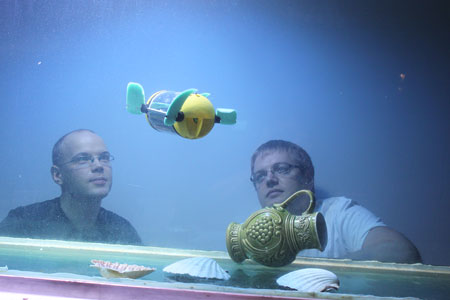| Nov 26, 2013 |
A robot turtle will help underwater archaeologists to inspect shipwrecks
|
|
(Nanowerk News) The Robot Safari at the London Science Museum will see the world premiere of the underwater robot U-CAT, a highly maneuverable robot turtle, designed to penetrate shipwrecks.
|
|
U-CAT’s locomotion principle is similar to sea turtles. Independently driven four flippers make the robot highly maneuverable; it can swim forward and backward, up and down and turn on spot in all directions. Maneuverability is a desirable feature when inspecting confined spaces such as shipwrecks. The robot carries an onboard camera and the video footage can be later used to reconstruct the underwater site.
|
 |
| Researchers Asko Ristolainen and Taavi Salumäe looking the u-CAT swimming in an aquarium at Centre for Biorobotics.
|
|
“U-CAT is specifically designed to meet the end-user requirements. Conventional underwater robots use propellers for locomotion. Fin propulsors of U-CAT can drive the robot in all directions without disturbing water and beating up silt from the bottom, which would decrease visibility inside the shipwreck”, says Taavi Salumäe, the designer of the U-CAT concept and researcher in Centre for Biorobotics, Tallinn University of Technology.
|
|
“The so called biomimetic robots, robots based on animals and plants, is an increasing trend in robotics where we try to overcome the technological bottlenecks by looking at alternative technical solutions provided by nature ”, explains Prof. Maarja Kruusmaa, a Head of Centre for Biorobotics.
|
|
Underwater robots are nowadays mostly exploited in oil and gas industry and in defense. These robots are too big and also too expensive to be used for diving inside wrecks. Shipwrecks are currently explored by divers, but this is an expensive and time consuming procedure and often too dangerous for the divers to undertake. U-CAT is designed with the purpose of offering an affordable alternative to human divers.
|
|
U-CAT is part of an EU funded research project ARROWS, which is developing technologies to assist underwater archaeologists. The technologies of the ARROWS project will be tested in the Mediterranean Sea and in the Baltic Sea, two historically important but environmentally different regions of Europe. “In the ARROWS project, the U-CATs would work in cooperation with larger underwater robots and together with image recognition technologies for discovery, identification and reconstruction of underwater sites, would facilitate the work in all phases of an archaeological campaign”, says Dr. Sebastiano Tusa, an underwater archaeologist from Sicilian Regional Government.
|
|
At the London Science Museum, the team will show the U-CAT robot as well as its interactive downscaled models u-CATs operating in an aquarium. Robot Safari is open for visitors from 28 November to 1 December.
|

